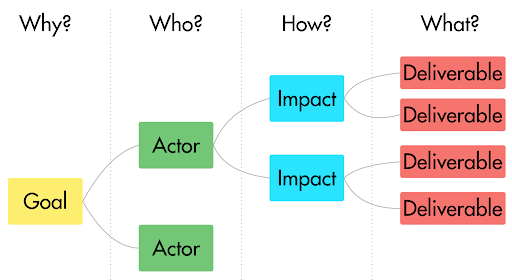What is Impact Mapping?
Impact Mapping is a strategic planning technique used to establish and visualize the relationship between a specific business goal and the means for achieving it. This includes identifying the actors (aka, key stakeholders) involved, the unique role each actor plays (and the impact they make), and what deliverables they use to drive that impact.
Designed by Gojko Adzic, an influential author and strategist within the Agile community, this workshop is ideal for creating alignment, facilitating collaboration, and increasing interaction between senior technical and business decision-makers.
More specifically, Impact Mapping forces teams to define and challenge the assumptions underpinning specific business objectives. Similar to Mind Mapping, this visual workshop method ensures that key decision-makers can build a shared understanding of underlying hypotheses and big-picture thinking as it relates to organizational objectives and challenges.
Typically used as a tool for building iterative, medium-term plans, Impact Mapping perfectly embodies the ‘Build-Measure-Learn’ feedback loop from the Lean Startup method. At the end of each strategic cycle, this workshop provides an ideal opportunity to measure progress against goal achievement and also validate existing assumptions. This allows participants to reevaluate their strategies regularly (and objectively) in order to make more informed decisions about whether to maintain the current strategic direction or change course slightly.
How to build an Impact Map
An Impact Map is made up of four tiers:
- The Goal (Why?): The first tier of the Impact Map answers the question: Why are we doing this in the first place? This business objective should be formulated as a SMART goal (Specific, Measurable, Action-oriented, Realistic, and Timely) and also clearly explain why achieving this goal will be useful for the organization as a whole.
- The Actors (Who?): The second tier identifies the actors involved who can influence the final, desired outcome (i.e. achieving the stated goal). In this part of the workshop, you should answer the following questions:
- The Impacts (How?): The second tier identifies the actors involved who can influence the final, desired outcome (i.e. achieving the stated goal). In this part of the workshop, you should answer the following questions:
- Whose behavior do we want to impact?
- Who can produce the desired effect?
- Who can obstruct it?
- Who are the consumers or users of our product?
- Who will be impacted by it?
- The Deliverables (What?): The third tier focuses on the impact you hope to drive via the actors above. To do this, start by answering these questions:
- How should our actors’ behavior change?
- How can they help us achieve the goal?
- How can they obstruct or prevent us from succeeding?
- The Deliverables (What?): The last tier is all about determining what product features or organizational activities are required to reach the desired impact from the previous step. Here, you need to ask yourself: What can we do, as an organization or delivery team, to drive this impact?

Impact Mapping is, therefore, a great way to create a clearer link between deliverables and their associated impact and goals. This is useful for both reevaluating key business decisions and reprioritizing the product roadmap over time. Because it is effective at shining a spotlight on short-term strategic challenges, the Impact Mapping workshop can be used alongside the OKR Framework for addressing operational objectives in a more detailed and comprehensive way.
Gojko Adzic’s Impact Mapping tips
After having run many Impact Mapping workshops himself, Adzic has identified some common facilitation pitfalls to avoid:
- Getting too many people involved: The more people there are in a workshop, the more difficult it is to facilitate. Try limiting the session to five or six people max.
- Inviting the wrong people to participate: The workshop should only involve technical experts and senior business owners who have real decision-making power—and whose opinions are respected across the organization.
- Criticizing ideas too early on: Be sure to leave room for ideation and divergent thinking during the first phase of the workshop. Criticizing ideas too early on in the process can kill a normally productive discussion before anyone has the opportunity to come up with potential alternatives.
- Reverse-engineering an existing feature list: Some participants come to an Impact Mapping workshop with a clear list of features to implement—and then use that as ammunition to influence the group towards supporting those features. A workaround for this would be to use that list to draw the map skeleton, thereby encouraging participants to think about all possible alternatives—and not just the feature set they’ve come to promote.
- Going into too much detail too early on: Since the Impact Mapping technique is a purely iterative process, it’s not worth getting too far into the weeds at any point. Instead, try to focus more time and energy on identifying the right actors and impacts first. The deliverables that result will simply be a natural result of those decisions.
Suggested resources to run effective Impact Mapping workshops
- The official website introducing the method: impactmapping.org.
- An almost one-hour keynote about Impact Mapping from Gojko Adzic: Keynote - Impact Mapping - Gojko Adzic
